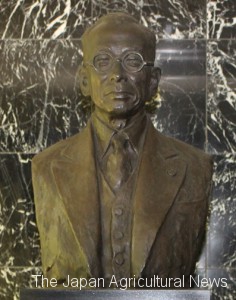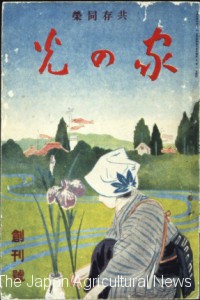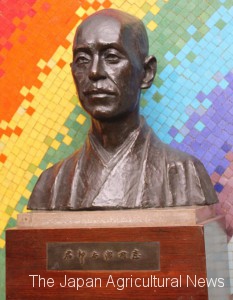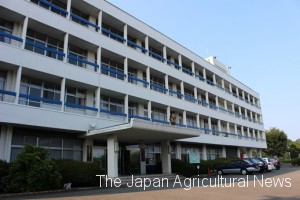According to investigation of sangyokumiaichuokai (general association of cooperatives) in 1925 (Taisho 14 ‘s), there were 12,500 Sangyokumiai (cooperatives) composed by 3,936,000 members. Only a few times of meetings and seminars a year were not enough for mobilizing this scale of human mind. Gentaro Shimura, president of sangyokumiaichuokai, thought that it was necessary to use the printed magazine in order to penetrate movement into nationwide members of sangyokumiai(cooperatives).
At the time, there was already a monthly organization magazine, “sangyokumiai (cooperatives).” But Shimura had the image of magazine not only for members of sangyokumiai but also for the family of members. Shimura consulted the improvement measures of the magazine to Kotaro Sengoku, shuji (secretary).

The statue of Gentaro Shimura (top) and Kotaro Sengoku (in the JA National Education Center of Machida city, Tokyo)
“Magazine can not be published in the spare time. Let’s adopt the editing experienced person,” said Sengoku. He looked for the right person. Sengoku selected Hideo Arimoto, his junior in Hokkaido University era.
Arimoto experienced edition work for the newsletter at chamber of agriculture of Hokkaido. After that work, he had been editing the magazine “Noka-no-tomo (friend of the farmer)” at chamber of agriculture in Okayama prefecture, his hometown. This magazine was said to be issued 50 thousand copies in exceptional.
Shimura consulted Kanji Sato (The dean of Faculty of Agriculture of Tokyo Imperial University length after) about the reform of the magazine “sangyokumiai (cooperatives)”. Sato said, “We must consider it separated from the magazine for members. In order to bring home the spirit of sangyokumiai (cooperatives), it’s necessary to make contents which can be understood for women and old people.” (Kanji Sato, ” Pioneer and the reverse”)
Shimura adopted Arimoto. He called him to sangyokumiaichuokai, and asked for creating the idea of the new magazine. Arimoto made and submitted a plan for how much it will cost the editing content and printing cost.
Magazine’s name was recruited from within the association. There were raised candidacies such as “kyoei (prosperity),” “kyodo (cooperative)”, “wago (harmony)”, “yorokobi (joy)”, “moyai (mooring rope).” The association referred also the name of other magazine, such as “Wagaya (My home)” magazine issued by Dainihonfujinkai (large Japan Women’s Association), and “Sanshinohikari (light of silk thread)”magazine issued by Zenkokuyosanshikumiairengokai (national federation of silk thread cooperatives).
Magazine name was decided in the “Ienohikari (Light of home)”. There was some possibility that the association used the translated name of “Light-of-home” which was the name of foreign magazine.
Shimura said. “In the case of caused loss, I’m going to make up for it by investing my own money.”
◇

The first issued magazine of the “Ienohikari (Light of home)” (provided by Ienohikarikyokai (Ienohikari association))
Sengoku advised another thing to Shimura. ” I think that it is necessary to found school to create successors mastering cooperative spirit.”
Shimura agreed with him, and consulted Sato who had put himself in the educational world. Sato also agreed and said, “The school should teach the practice helpful immediately after graduation, not to fall into the pursuit of scientific principle, in order to create the core person to lead members”. Regarding of the number of students, he said, “30 is good.” He claimed that for teachers, in order to seize the nature of the student and instill the cooperative spirit, the number of students should be limited to 30. Regarding academic level, he said, “It should become professional school targeting the graduates from junior high school (now high school).”
There was criticism such as, ” 30 is short. It’s like Terakoya (temple elementary school during the Edo period).” But Shimura executed following the instructions of Sato.
In April 1926 (Taisho 15), the school was opened as “sangyokumiaichuokai fuzoku sangyokumiaigakko (cooperatives school affiliated with general association of cooperatives)”. School building was located at the second floor of Zenkoren building in Ageha-cho of Ushigome-ku (now Shinjuku-ku) of Tokyo city. Shimura was appointed the first president and Sato was appointed the dean.
The number of applicant for admission of the first year was worried, but it ended in groundless. 220 people, which was more than 7 times of recruitment, applied for the school. However, Shimura who finished the opening ceremony had felt something unsatisfactory. He considered whether only education in the classrooms was enough for students who moved from the province to Tokyo having expectations. He began to think that, as a model of the University of Cambridge UK, the school should let students stay at dormitory and study, so as to produce no failure. Shimura offered a donation of dormitory named “Rishisha (fixing aim house)”. (Shimura Gentaro Den Kankokai (biography publication association of Gentaro Shimura) “Gentaro Shimura its people and performance”, Kazuo Takemori “Kotaro Sengoku”, Kanji Sato “biography of Kanji Sato”)
School was then moved to Tokyo metropolitan area, the name was also changed as follows;Chuonogyokaigakko (School of Central agricultural institution) during the Second World War,Zaidanhojin kyodokumiaigakko (Cooperatives school, Foundation) at post-war,Gakkohojin kyodokumiaitankidaigaku (Cooperatives Junior college, Incorporated educational institution) after 1955 (Showa 30),Kyodokumiaigakuen (Cooperatives Academy),And now it has become JA national Education Center. For its long history, there was no change of the idea to raise the cooperative’s next generation.



